84 Fashion Industry Marketing Leaders Reveal the Impact of Experiential Strategies on Their Brands
We’re excited to bring you our latest insights into the experiential marketing trends driving the Fashion industry forward.
Our research included insights from interviews with 15 C-suite executives and comprehensive surveys of over 750 senior brand marketers spanning over 12 industries.
Notably, 84 of these specialists work directly in the Fashion industry, and we have meticulously filtered their responses to provide a detailed comparison of their practices against those in other sectors.
This report provides a deep dive into how the industry is leveraging experiential marketing to create memorable brand experiences and stay ahead in a competitive market.
The complete study, featuring expertly visualized data and comprehensive analysis, will be available on our website soon. In the meantime, we've crafted an exclusive preview tailored specifically for the fashion industry.
Over the past three years, 85% of Fashion companies have increased their experiential marketing budgets, surpassing the average in other industries.
Among the Fashion companies we surveyed, 71.43% report revenues between $50 million and $1 billion. This is higher than the 40.98% average across other industries in our survey, suggesting that the brands involved in experiential marketing tend to be larger and more established.
They allocate 10-30% of their overall budget to experiences or events, which is in line with the industry average.
Pauline, Gradient's CEO, says, “What brands are realizing is that while e-commerce is great, being able to see, touch, and smell garments is irreplaceable.”

Over the past three years, 85% of Fashion companies have increased their experiential marketing budgets, with 34% reporting significant growth. This is notably higher than the 75% average across other industries, where only 29% report significant increases in their experiential marketing budgets.
ROI Priorities in: Awareness and Sales
Awareness and Sales are the top ROIs from experiential marketing campaigns or events.
Awareness is considered the most important by 30% of respondents, compared to the 19% overall average.
Sales is prioritized by 39%, significantly higher than the 22% average across other industries.
Lead Generation also ranks higher in (17% most important) compared to the overall average (10%).
In contrast, Consideration and Loyalty are less emphasized compared to sectors like Travel & Transport or Hospitality.

Only 17.31% of Fashion marketers express high satisfaction with their ability to measure ROI, which is lower than the average across other industries.
Unlike Sales, which can be tracked more directly through sales data, Awareness often relies on less tangible metrics like brand recall, media impressions, or social media engagement, making precise measurement more difficult.
Additionally, Lead Generation can be complex to track effectively, especially when leads take time to convert or are influenced by multiple touchpoints beyond the event itself.
Measuring Campaign Success
Fashion companies prioritize earned media value (64%) and social engagement (53%), both of which are slightly above the average.
Pauline says, “Experiential drives more content creation as consumers will produce UGC from experiences rather than purchases alone – leading to a wider brand reach and earned media.”
The industry’s emphasis on earned media value and social engagement underscores the importance of public perception and digital influence in the industry.

Objectives of Experiential Marketing Campaigns
Key Objectives: Content creation (48%) and relationship-building (43%) are the primary objectives for experiential campaigns.
The focus on content creation and relationship-building in the Fashion industry highlights the sector’s reliance on storytelling and personal connections to build brand loyalty.
Pauline says: “In a saturated fast-fashion market, brands that invest in human connection via IRL experiences can form longer relationships with greater loyalty.”
Fashion brands use experiential marketing to create visually compelling and shareable content that resonates with their audience while fostering deeper relationships with consumers. This approach is particularly effective in an industry where brand image and consumer identity are closely intertwined.
Pauline says: “The best brands merge experiential with retail. For example, bricks-and-mortar is re-emerging less as a sales need and more as a brand statement or experiential playground. A great example is KITH, which operates in-store ice cream shops.”
Budget size and allocation (58%) and internal cross-collaboration (55%) are the biggest challenges
The challenges faced by Fashion marketers, particularly in budget allocation and cross-collaboration, suggest difficulties in balancing the high costs of experiential campaigns with the need for cohesive marketing strategies across various departments.

These issues may be exacerbated by the fast-paced nature of the fashion industry, where marketing teams must quickly adapt to new trends while coordinating efforts across multiple channels. Addressing these challenges could involve more strategic planning and improved communication between departments to ensure that experiential marketing initiatives are well-supported and aligned with broader business objectives.
Experiential events in Fashion are typically integrated at the beginning and during the creative development stage of a campaign
Experiential events in Fashion are typically integrated at the beginning (29%) and during the creative development stage (26%), closely aligning with the timing seen across other industries.
72.73% of Fashion marketers believe, however, that experiential marketing should be integrated earlier or more holistically into campaign development.


